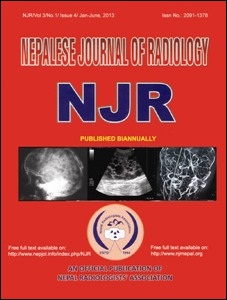Imaging Features of Intracranial Meningiomas with Histopathological Correlation: A Relook into Old Disease
DOI:
https://doi.org/10.3126/njr.v3i1.8713Keywords:
meningiomas, intracranial, imaging characteristics, complete imaging featuresAbstract
Background and Purpose: Imaging characteristics of meningiomas have been discussed previously in many studies; however complete imaging features involving general features, MRS and DWI of both typical and atypical meningiomas have been discussed in very few studies. CT and MR imaging findings in 46 cases of intracranial meningioma are reviewed to define specific imaging features.
Methods: The present study was carried on 46 patients in the Department of Radiodiagnosis and Imaging, Institute of Medical Sciences, Banaras Hindu University during June 2009 to July 2011.The investigation was carried out by GE-VCT 64 Slice Scanner machine and Magnetic resonance imaging was contemplated using 1.5 Tesla SIEMENS-MAGNETOM AVANTO. CT and MR imaging studies were reviewed to characterize mass location, imaging characteristics, atypical features and advanced imaging features. Clinical presenting signs and symptoms were correlated with imaging findings.
Results: a). Forty six cases of intra cranial meningiomas were studied prospectively in 24 women and 22men, aged 11 – 80 years. Meningiomas were stratified into typical and atypical and also depending upon intra cranial location. b). 73.91% of the cases in showed supratentorial location, rest were infratentorial (26.08%).CT/MRI revealed well defined margins in 84.78% with homogenous consistency in 73.91% of lesions. Foci of necrosis were noted in 32.60% of cases and 15.22% of cases showed calcification foci in meningioma. Sinus invasion noticed in 15.22% of cases, whereas adjacent bony reaction noticed in 30.43% of cases. c). Majority of Meningioma showed broad dural base (89.10%), adjacent white matter buckling (71.74%) and surrounding CSF cleft (52.17%). Displaced subarachnoid vessels were demonstrated in 30.43%, where as the pathognomonic dural tail was present in only 23.91% of the cases. d). All the cases of Meningioma demonstrated restriction on diffusion weighted sequences suggestive of high cellularity of the lesions. On CT angiography, neovascularity was noticed in 85.71% and tumor blush was noticed in 71.42% incidence. On MR Spectroscopy, all demonstrated choline peak and in one third cases alanine peak was discernible.
Conclusion: In view of the observed evidence, it was concluded that understanding the classification, pathology and imaging appearance meningioma are essential for treatment planning. CT and MR imaging play indispensable role in the localization & characterization of these tumors, and MR have virtually yielded its position of dominance in characterizing these tumors.
Nepalese Journal of Radiology / Vol.3 / No.1 / Issue 4 / Jan-June, 2013 / 14-32
Downloads
Downloads
Published
How to Cite
Issue
Section
License
This license enables reusers to distribute, remix, adapt, and build upon the material in any medium or format, so long as attribution is given to the creator. The license allows for commercial use.




